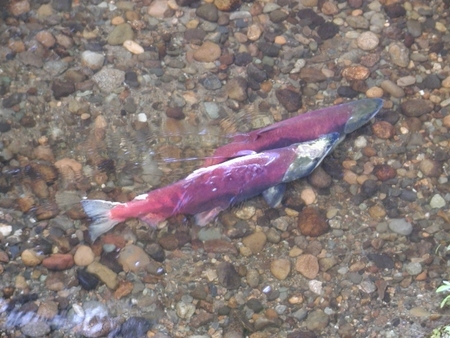‘Salmon SEEson’ returns: Where to spot fish as they come home to spawn in King County rivers and streams
Summary
Salmon are coming home to spawn in King County’s rivers and streams – find details on self-guided and virtual viewing opportunities on the Salmon SEEson website.
Story
Pacific salmon – including sockeye, Chinook, coho, pink, and chum – have begun the journey from the open ocean to their birthplaces to spawn in streams and rivers that feed into Puget Sound. Lake Sammamish kokanee, which are landlocked sockeye salmon that spend their entire lives in freshwater, will soon move into streams feeding the lake to spawn.
Chinook, coho, pink, and chum – have begun the journey from the open ocean to their birthplaces to spawn in streams and rivers that feed into Puget Sound. Lake Sammamish kokanee, which are landlocked sockeye salmon that spend their entire lives in freshwater, will soon move into streams feeding the lake to spawn.The Salmon SEEson program helps people witness these amazing migrations at locations around King County.
Find self-guided viewing locations as well as virtual viewing opportunities on the Salmon SEEson website. If you decide to visit a self-guided site, please remember to follow current public health guidelines and plan ahead: Practice physical distancing, wear a mask, choose a site near you, leave no trace, and contribute to an inclusive experience for all.
These salmon-viewing locations offer the best chances of seeing salmon – particularly during a year when many stocks are returning in below-average numbers.
Each year, the Muckleshoot Indian Tribe and Washington Department of Fish and Wildlife count numbers of salmon returning through the Ballard Locks fish ladder from mid-June to early October. Sockeye typically migrate through the Ballard Locks from May to August, followed by Chinook from July to September, and coho from late August to November.
In recent years, sockeye numbers have declined substantially in the watershed. Chinook returns remain well below population recovery goals. Lake Sammamish’s native kokanee population has been in decline for the last few decades, and King County and partners continue to take actions to avoid possible extinction.
Salmon are sensitive to the changing climate, including warming lake and stream temperatures. Warmer water stresses salmon and can increase salmon susceptibility to disease and increase predator metabolism and consumption of juveniles as they migrate out to saltwater in Puget Sound.
Salmon are a Pacific Northwest icon and a vital cultural, economic, and environmental resource for our region. Local governments and community groups around King County and Puget Sound are working to recover salmon populations by protecting and restoring habitat, managing stormwater runoff from streets and other hard surfaces, and educating the public about what they can do to help.
Working to recover salmon is about more than salmon – it is fundamentally about caring for our home and making our communities sustainable for the long-term. Protecting and restoring salmon habitat also improves water quality, reduces flood hazards, protects open space, improves stormwater management, sustains and improves our quality of life, and promotes a proud legacy of stewardship for future generations.
Practicing water conservation and pollution prevention year-round helps salmon thrive, which means more fish can survive and continue their journey to the ocean and back to local streams and rivers.
Salmon SEEson is sponsored by the WRIA 8 Salmon Recovery Council as part of its effort to recover salmon in the Lake Washington/Cedar/Sammamish Watershed. Additional sponsors include the Saving Water Partnership, Duwamish Alive Coalition, the Green/Duwamish and Central Puget Sound Watershed, the Snoqualmie Watershed Forum, and King County.
For more information, visit kingcounty.gov/see-salmon-safely.
RELEVANT LINKS
• kingcounty.gov/see-salmon-safely
• King County guidance for COVID-19 safety
• Learn about salmon recovery work in King County
FOR MORE INFORMATION, CONTACT:
Doug Williams, Department of Natural Resources and Parks, 206-477-4543
About DNRP
The King County Department of Natural Resources and Parks works in support of sustainable and livable communities and a clean and healthy natural environment. Our mission is to foster environmental stewardship and strengthen communities by providing regional parks, protecting the region's water, air, land and natural habitats, and reducing, safely disposing of and creating resources from wastewater and solid waste.

 Translate
Translate